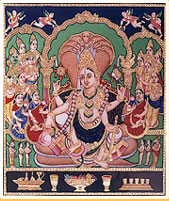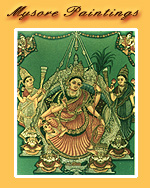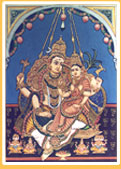Contribute
| South Asian Art History - In Memory Of Prashant H. Fadia |
Dr. Ramaa Narayanan
08/07/2007
Mysore Paintings are devotional pictures of gods, goddesses and saints. The iconic idiom is rich in the material used – finely prepared colours and abundant use of gold leaf. The style is of plentiful details meticulously rendered. Mysore Paintings share striking similarities with the better-known Tanjore Painting – Tanjavur Oviyam.(ref: www.lokvani.com; May 17- 2007). No wonder, because, Tanjavur Painting and Mysore Painting are parallel traditions stemming from the same Carnataka culture and the arts of Vijayanagara empire; both emerged around 1600 CE.
On the weakening and subsequent disintegration of the Vijayanagara kingdom in the late sixteenth century, a group of artists belonging to the Telugu speaking Raju community found patronage at Tanjavur town under the Nayakas of Tanjavur. Another group started to enjoy sustained patronage under the Wodeyars of Mysore, especially Raja Woodeyar and Mummadi Krishnaraja Woodeyar. The migrant artists carried with them seed of creativity - that of a resplendent imagination of divine images that blossomed into two schools of portable icons; both producing distinctly unique body of work. Eventually, these paintings found its place in palaces, temples, mansions, community buildings and houses belonging to the wealthy and the landed.
The traditional Mysore Paintings depict the gods or goddess in simple compositions. Gods are either depicted alone, or as often, are grouped with associated figures. In either case, they are prominently ‘enthroned’ as though in a sanctuary, durbar or sadas. Simhasana – similar in design to the throne of the Mysore Wodeyar kings, swing, lotus bloom, or the vahana of the particular deity provides a stable seat. The setting may include vimana–pavilion of the conventional religious art or palatial interior suggested through stately or ornate architectural details, carpets etc. The painting may or may not include other subordinate figures of devotees and attendants. Sometimes offerings may be arranged along the base. The background is filled with unmodulated, flat colours. The painting is luminous in a wide spectrum of pure colours and abundant use of gold. Mysore paintings enthrall.
Dasavatara and Sri Rama Pattabhisheka are common pictures. The land of its birth being closely associated with Devi Mahishasuramardini, female goddesses of Chamundeswari, Lakshmi, Saraswati, constitute favourite subject matter. Krishna of various forms and poses, Tandveshwara, etc. are painted, too. The themes of Vishvarupa-darsha and Samudramandana (Churning of the Ocean) are rendered in spectacular manner. A rare painting of visvarupa of Chamundeswari has the pride of place in an exclusive collection of Mysore Paintings belonging to a Chennai-based art lover. Portraits of heroes and kings depicted in this style are simply beautiful. In painting the deities the iconography is followed closely. The mytho-religious themes, from Ramayana for instance, adhere to thematic references to the figures to be portrayed and to the scheme of traditional painting of the land., as well.
Commonly referred to as ‘gesso painting’, Mysore Painting is a combination of flat painting with colours and judiciously raised surfaces achieved through gesso work further overlaid with gold foil. The face and the exposed parts of the body are painted in ivory, and light brownish tints. The jewels, especially the kirita makuta (gem-studded crown), as well as a major part of the setting like pavilion, pillars, arches, throne, carpets, bolsters, curtains are depicted in gilded gesso. The harmonious use of colours enhanced further by work in gold is a main characteristic of Mysore Painting. The gesso work apart the painted areas are artistically treated. The patterns on the robes, cushions, carpets, etc. display a high degree of brushwork, thus endorsing both the dexterity of hand and a love for the work on hand. The devotional attitude is evident in all aspects of the art.
To be continued...
You may also access this article through our web-site http://www.lokvani.com/


